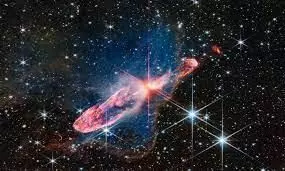
NASA's James Webb telescope captures supersonic outflow from young star resembling early Sun
text_fieldsWashington: The James Webb Space Telescope (JWST), NASA's groundbreaking observatory, has captured a striking image of a young star emitting supersonic jets of star matter.
This image offers a glimpse of what our Sun might have looked like thousands of years ago.
The remarkable photograph reveals jets of star matter shooting from the poles of the young star, known as Herbig-Haro (HH) 211, at supersonic speeds.
HH 211 is situated approximately 1,000 light-years away from Earth in the Perseus constellation. The bright regions surrounding newborn stars, like those observed in the image released by the space agency, are referred to as Herbig-Haro objects.
NASA shared the image on its official Instagram account and wrote, "If we could take a baby picture of our Sun, it might look something like this. Seen in this @NASAWebb image is a newborn star with supersonic jets of gas spewing from its poles. It's only a few tens of thousands of years old here, but when it grows up, it'll be much like our Sun."
Herbig-Haro objects are formed when stellar winds or gas jets from these nascent stars generate shockwaves upon colliding with nearby gas and dust at high velocities. HH 211, in particular, is a Class 0 protostar, which is only a few tens of thousands of years old and possesses a mass roughly 8 percent that of the Sun. Nevertheless, it is anticipated to mature into a star resembling our Sun.
The JWST's ability to capture the structure of these outflows is due to the infrared light emitted by excited molecules, such as molecular hydrogen, carbon monoxide, and silicon monoxide.
This newly-released image provides unparalleled detail of the young star's surroundings, with a resolution 5-10 times higher than any previous capture of HH 211.
The JWST, launched in 2021 and commencing data collection in 2022, has significantly expanded our understanding of the early universe and provided breathtaking images of celestial phenomena. Since becoming operational, it has unveiled the earliest-known galaxies and black holes, delivering an abundance of unprecedented data.
The JWST is approximately 100 times more powerful than the Hubble Space Telescope.
























